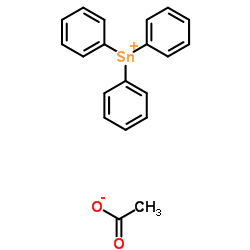FENTIN ACETATE

FENTIN ACETATE structure
|
Common Name | FENTIN ACETATE | ||
|---|---|---|---|---|
| CAS Number | 900-95-8 | Molecular Weight | 409.066 | |
| Density | 1.55 | Boiling Point | N/A | |
| Molecular Formula | C20H18O2Sn | Melting Point | 118-122°C | |
| MSDS | Chinese USA | Flash Point | N/A | |
| Symbol |




GHS05, GHS06, GHS08, GHS09 |
Signal Word | Danger | |
|
Characterisation of gene expression patterns in 22RV1 cells for determination of environmental androgenic/antiandrogenic compounds.
J. Steroid Biochem. Mol. Biol. 84(2-3) , 231-8, (2003) Alteration of androgen receptor function due to hormonally active compounds in the environment, may be responsible for impaired reproductive function in aquatic wildlife. Based on human prostate carcinoma 22RV1 cells, a cell culture expression system was esta... |
|
|
Genotoxic effects of triphenyltin acetate and triphenyltin hydroxide on mammalian cells in vitro and in vivo.
Mutat. Res. 444(1) , 167-74, (1999) Two organotin pesticides, triphenyltin acetate (TPTA) and triphenyltin hydroxide (TPTH), were evaluated for their ability to induce micronuclei (MN) and sister chromatid exchange (SCE) in vitro using cultured Chinese hamster ovary (CHO) cells and in vivo BALB... |
|
|
The comparative effects of subchronic administration of triphenyltin acetate (TPTA) on the hepatic and renal drug-metabolizing enzymes in rabbits and lambs.
Vet. Res. Commun. 21(2) , 117-25, (1997) The purpose of this study was to determine whether subchronic (70 days) oral exposure to moderate to high levels of triphenyltin acetate (TPTA), an organotin derivative used worldwide, would affect the microsomal hepatic and renal drug-metabolizing enzymes in... |
|
|
Acute nephropathy of organotin compounds.
Am. J. Nephrol. 13(2) , 124-8, (1993) Three patients who developed acute nephropathy following ingestion of triphenyltin acetate (TPTA) are described. All of them had significant proteinuria, azotemia, and polyuria. Mild neurological manifestations in all patients were also noted. Hematuria and p... |
|
|
Triphenyltin acetate toxicity: a biochemical and ultrastructural study on mouse thymocytes.
Hum. Exp. Toxicol. 15(3) , 219-25, (1996) 1. Triphenyltin acetate (TPTA) has been shown to exert in vivo a selective toxic effect on the immune system. To assess in vitro possible alterations induced by TPTA exposure, primary cultures of mouse thymocytes were incubated up to 24 h with graded amounts ... |
|
|
Differential response of four cyanobacterial and green algal species to triazophos, fentin acetate, and ethephon.
Bull. Environ. Contam. Toxicol. 73(5) , 890-7, (2004)
|
|
|
Biochemical, ultrastructural and molecular characterization of the triphenyltin acetate (TPTA)-induced apoptosis in primary cultures of mouse thymocytes.
Cell Biol. Toxicol. 22(4) , 275-84, (2006) Triphenyltin acetate (TPTA), a triorganotin compound used in agriculture as a biocide, is immunotoxic in vivo and in vitro. The present study was undertaken to ascertain whether apoptosis might play a role in the TPTA toxicity in vitro. Mouse thymocyte primar... |
|
|
Apoptosis and CD4+, CD8+ lymphocyte depletion following triphenyltin acetate (TPTA) exposure in mice thymic primary culture.
Eur. J. Histochem. 41 Suppl 2 , 171-2, (1997)
|
|
|
Unique cerebral dysfunction following triphenyltin acetate poisoning.
Hum. Exp. Toxicol. 17(7) , 403-5, (1998) 1. In animal studies, TPTA was found to be neurotoxic. In humans, variable CNS pictures have been described with or without significant EEG findings. Brain CT does not usually reveal any abnormalities. 2. Our patient presented with intermittent unique spontan... |
|
|
Effect of Brestan on Saccharomyces cerevisiae during continuous cultivation.
Folia Microbiol. (Praha) 47(5) , 507-10, (2002) An increase in Brestan concentration in nutrient media decreased the content of protein, phosphorus, total ribonucleic acid, activity of pyruvate carboxylase and isocitrate lyase in cells of Saccharomyces cerevisiae parent strain and respiratory deficient (RD... |